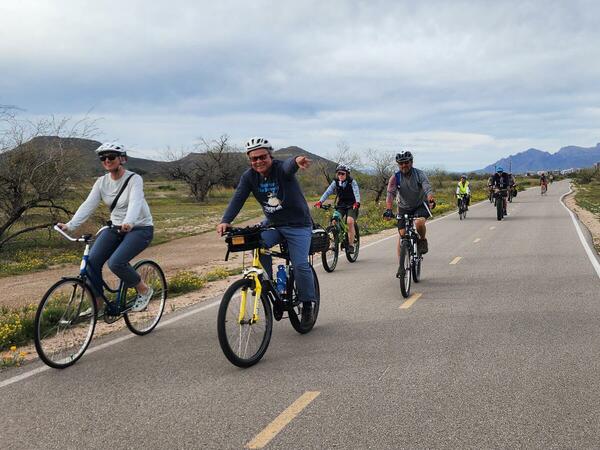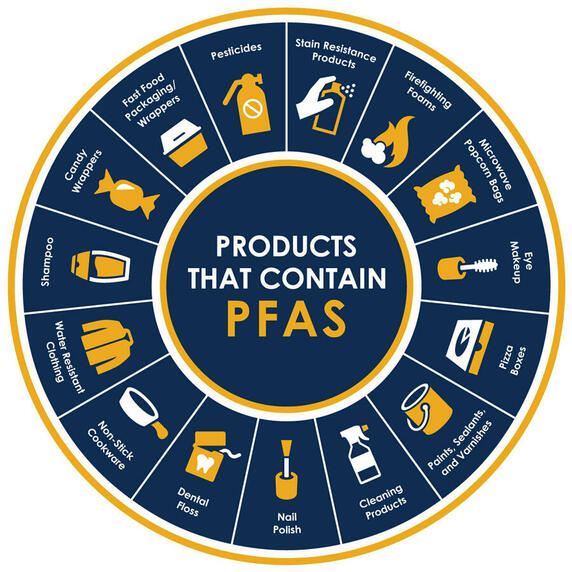Pedaling For Progress: The PFAS Problem
By: Max Wingert, Communication & Outreach Manager
“Before we begin, I need some volunteers. Three volunteers. Ok, you… you, and you. Now. I have a little test for you. We’ll start with you. Can you pronounce this?”
This question came from Joaquin Murrieta, the Cultural Ecologist Director of Watershed Management Group. He stood, smiling, surrounded by a semicircle of a dozen or so bicyclists, in a small parking lot adjacent to the Santa Cruz River.
He held up a piece of paper with an infographic on the front, and some big, bold words printed on the back. They read:
Per-and Polyfluoroalkyl Substances
Say that ten times fast, am I right? Or, you know, just one time, slow. As the brave volunteers discovered, this was a bit of a challenge. They took turns stumbling over the scientific-looking (and somewhat scary-sounding) words.
The good news is the short-hand name is much easier to pronounce: “PFAS” (pronounced “p-fas” - like what you try to do when you’re camping and you wake up in the middle of the cold night).
That’s what we were there to learn about. PFAS. A few more than a dozen adventurous folks had arrived on a gorgeous Thursday evening to go for a bike ride and learn about groundwater being treated for PFAS that is being released into the Santa Cruz River. The bike ride was offered through WMG’s River Run Network, and led by the renowned Joaquin Murrietta. We were there to discover and discuss the presence of PFAS in our city water supply: what it was, how it got there, what steps were being taken to clean it out, and why this water is being put in our river?
The PFAS problem
The issue of PFAS contamination in water supplies has emerged as a pressing environmental and public health concern across the United States, including but by no means limited to Tucson. These "forever chemicals," used in everything from cookware to firefighting foam, are notorious for their persistence in the environment and their potential to cause serious health issues, such as cancer, thyroid disease, and developmental delays in children.
In Tucson specifically, the discovery of PFAS in groundwater near Tucson International Airport and Davis-Monthan Air Force Base has prompted significant action. The contamination, primarily attributed to the use of PFAS-containing firefighting foam, has affected water sources, necessitating an urgent response from Tucson Water.
Rather than allowing this issue to discourage us or keep us confined indoors, we decided to take action by embarking on a bike ride along the Santa Cruz River to the Tucson Water Plant. Our goal was to gain a firsthand understanding of one of our city's primary water sources and the efforts being made to address the PFAS contamination.
The Bike Ride Experience
And so we strapped on our helmets and went for a ride. The weather was perfect. The participants were enthusiastic and eng aged. And the leader of our trip, Joaquin, never runs short of interesting and inspiring things to say.
aged. And the leader of our trip, Joaquin, never runs short of interesting and inspiring things to say.
We made a couple stops along the way, including the Santa Cruz River Heritage release site, which expels treated wastewater (recycled water), and the Irvington outfall, which releases treated groundwater that was contaminated with PFAS and trichloroethylene (TCE) into the Santa Cruz River. TCE is an industrial solvent that has been detected in the groundwater of southern Tucson, forming another pollution plume in addition to the PFAS contamination.
We made a couple stops along the way. Much of our discussion did revolve around PFAS. As it turns out, that term doesn’t refer to 6 or 8 or 10 chemicals… it refers to about 6 or 8 or 10 THOUSAND different chemicals.
These chemicals are EVERYWHERE… and, according to Leif Abrell, a University of Arizona chemist who studies these chemicals every day who also just so happened to be along for the bike ride, scientists have truly only begun to scratch the surface of what these pervasive pollutants are, what they do, and how we even begin to remove them from our water supply (let alone our very bodies/blood).
“There are literally thousands of PFAS.” Leif informed us, frankly. “And we’ve really only begun to study, like, four.”
Silence greeted these words as their gravity set in for the rest of us.
“But, hey, we’re working on it.”
I pulled out my phone and started searching online for water filters. Something told me my Britta just wasn’t going to cut it anymore.
Tucson’s Response to PFAS
Tucson Water is actively working to mitigate the impact of PFAS and TCE contamination in the groundwater of southern Tucson. When a concentrated plume of pollution is identified, spreading in the direction of the groundwater flow, the city takes steps to contain the plume and prevent the further spread of contaminants. This is achieved by pumping out the contaminated water at the source, treating it, and then releasing the treated water back into the Santa Cruz River.
Historically, TCE was detected in the drinking water sources of residents in southern Tucson, leading to significant health concerns and negative publicity. In response, Tucson Water has made the decision to release the treated groundwater into the river or into the recycled water system, rather than reintroducing it directly into the drinking water supply.
It is important to note that PFAS is present in our waste water, which is processed by wastewater treatment facilities. The Pima County Regional Wastewater Reclamation Department treats this water to a standard suitable for use as reclaimed water in applications such as irrigating golf courses and parks, however, it still contains low levels of PFAS. While PFAS is present in all of our water to some degree, it is significantly more concentrated in the groundwater of southern Tucson.
That said, it’s spreading. The current situation has effectively mobilized PFAS across our water sources, inadvertently contributing to the spread of these contaminants throughout…well everything. And, I hate to say, everyone. When we say “We Are One Watershed,” we’re really not kidding.
(It’s like that song we used to sing in kindergarten: “The river water’s connected to the… wastewater! And wastewater’s connected to the… groundwater! And groundwater’s connected to the…. drinking water.” Welcome to the watershed.)
It’s a big problem. And far too few are even aware of what’s happening. That’s why we hosted the bike ride. And that’s why I’m writing this blog post. Step one is to spread awareness. Can’t solve the problem if you don’t recognize there is one.
Step two, of course, is to buy a better water filter. I hear good things about Berkey Filters.
Final Thoughts
All in all, the bike ride was a success. Good people, coming together for education and exercise, for conversation and community. Together, we can make a difference.
I encourage you to join us for future River Run Network events like this one – bike rides, creek walks, river clean ups, you name it. There’s plenty on the horizon. We’d love to see you there.
Sign up for our weekly Tucson Action Bulletin to stay informed and get involved.
Additional Resources
The dangers of PFAS — and of downplaying their ubiquity (High Country News)
A quarter of rural water systems likely contain ‘forever chemicals’ (HCN)
The dangers of PFAS — and of downplaying their ubiquity (HCN)
Official health communications are failing PFAS-contaminated communities (Nat'l Library of Med)
